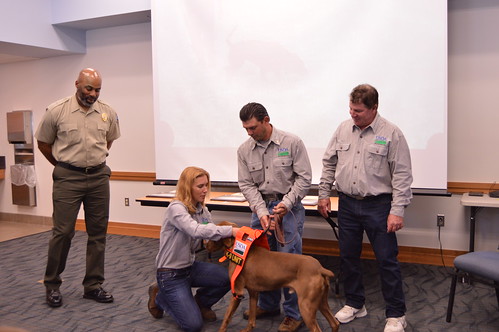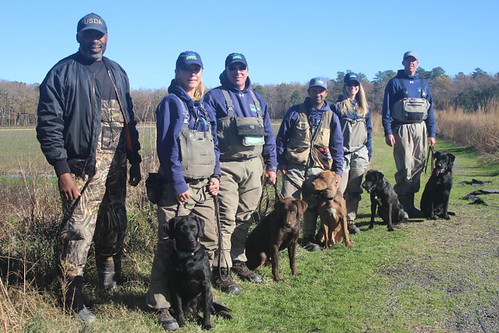
U.S. Department of Agriculture (USDA), Animal Plant Health Inspection Service (APHIS), Wildlife Services program specialist Mario Eusi and his dog Cain at their graduation ceremony certifying them for Nutria Detection at the Blackwater National, Wildlife Refuge, MD.
Mya, Hektor and Cain are seated on the floor, next to their handlers and partners, waiting for their names to be called. It’s a big day for the three shelter dogs and their handlers. You may be surprised to learn that many of the dogs trained at APHIS’ National Detector Dog Training Center are rescues. Mya and Cain are from Maryland’s Montgomery County Animal Services & Adoption Center and Hektor is from the Fulton County Animal Shelter in Atlanta. They are all officially graduating from the U.S. Department of Agriculture (USDA) Animal and Plant Health Inspection Service’s (APHIS) detector dog training program, and will join two other rescue dogs trained last year and currently part of other detector dog teams as part of the effort to find and eliminate the last of the nutria from the Delmarva Peninsula.
Nutria are invasive, semi-aquatic rodents that live in marshes throughout the country. They weigh between 12 and 20 pounds and were brought to Maryland’s Lower Eastern Shore from South America for their fur in 1943. However, their dark brown pelts were not profitable, and they were either released or escaped from fur farms. With no natural predators, the nutria population at Maryland’s Blackwater National Wildlife Refuge exploded.
Nutria feed off of the roots that bind marshes together. They have caused significant damage, changing the reedy marshes to open mudflats, increasing erosion, and impacting the native fish and wildlife that depend on the area for their habitat.
In 2002, APHIS began working with a group of Federal, State, local and private partners to eliminate nutria for the Delmarva Peninsula. This project, called the Chesapeake Bay Nutria Eradication Program (CBNEP), used a multifaceted strategy to rid this area of this damaging invasive species.
“We have achieved something that a lot of people thought could not have been done,” said Dean Hopkins, a wildlife specialist with APHIS.
About 14,000 nutria have been removed from more than 250,000 Delmarva acres. The hard work of this joint team has paid off, and there has not been a nutria spotted on the Delmarva Peninsula since May 2015.
The final stages of the eradication program are extremely difficult. It only takes two nutria of opposite genders to find each other and start breeding to have the population grow again. The canines are critical to these final stages. Trained specially to detect nutria’s scat or droppings, the dogs are able to cover a lot of ground quickly. If the dogs do not find any scat, the handlers can be confident that there are no nutria in that location.
“It is a game for the dogs,” said James Mason, a training specialist with the USDA’s National Detector Dog Training Center in Georgia. “We teach them to bark for the toy, and then we teach the dog that if he smells the scat, he gets the toy.”
The dogs and handlers trained together for seven weeks, three at the training center in Georgia and four in the marshes on the Delmarva. The handler/canine teams then had to pass a series of tests and find nutria scat before they could officially graduate as a detector dog team. The dogs are helping the handlers find the last remaining nutria on the peninsula, something humans cannot do alone. It is a partnership with a mission.

The team of handlers and detector dogs that are working on the final stages of the program to eradicate nutria from the Delmarva Peninsula.
No comments:
Post a Comment